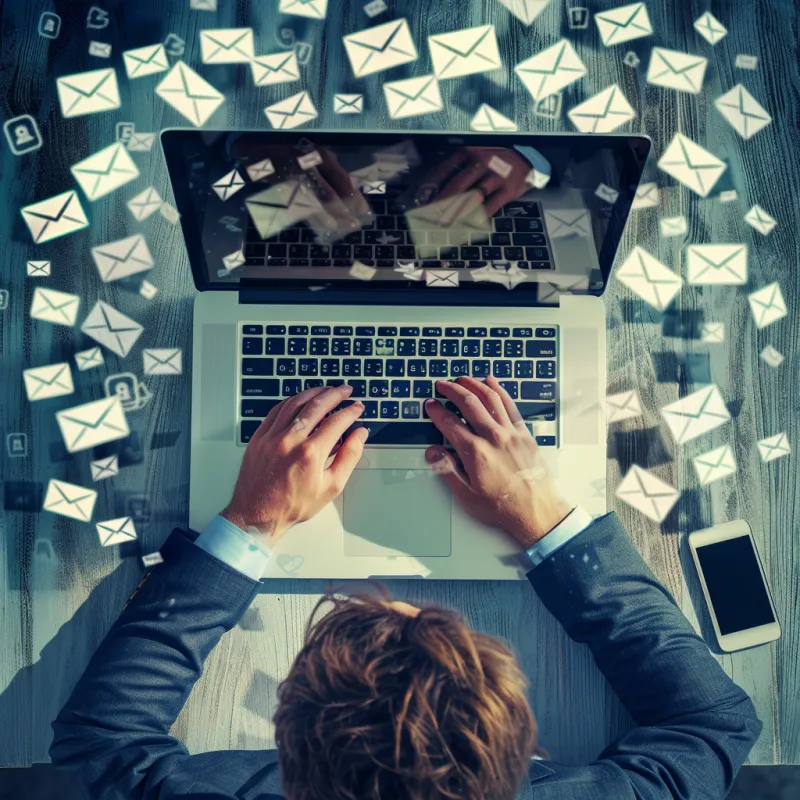A Guide to Email Broadcasting in 2024: Broadcast Email Benefits and More
A Guide to Email Broadcasting in 2024: Broadcast Email Benefits and More
Email broadcasts stand as a pivotal tactic for enhancing the success of email marketing campaigns. This guide will walk you through the nuances of email broadcasting in 2024, from its definition and importance to its different types and the workings of email autoresponders. Whether you're new to email marketing or looking to refine your strategies, this guide has you covered.

What is Email Broadcasting and Email Autoresponder?
Email broadcasting refers to the practice of sending a single email message to a large group of recipients simultaneously. Unlike one-to-one emails, broadcast emails target a broad audience with a unified message. This approach is essential for disseminating timely and relevant information to your entire email list, making it a cornerstone of any robust email marketing strategy.
Key takeaway: Email broadcasting is a critical tool for delivering consistent, wide-reaching messages to your audience, maximizing engagement and impact.
Definition and Importance of Email Broadcast: Send Emails in Bulk
An email broadcast is a mass communication tool used in email marketing to send out a single message to a large audience at once. It plays a crucial role in maintaining contact with subscribers, sharing updates, and promoting products or services. The importance of email broadcasts lies in their ability to reach many people quickly and efficiently, fostering customer relationships and driving conversions.
Key takeaway: Email broadcasts are vital for maintaining regular contact with a broad audience, ensuring that your messages are timely, relevant, and impactful.
Types of Broadcast Emails: Bulk Email Sending
Email Newsletters: These are regular updates sent to subscribers, often featuring curated content, industry news, and company highlights. Newsletters are designed to keep your audience informed and engaged with valuable information.
New Updates & Releases: These emails announce new product features, software updates, or other significant company developments. They keep your audience in the loop about the latest changes and innovations within your company.
Weekly/Monthly Digests: These are compilations of popular content, such as blog posts, podcasts, or videos, sent at regular intervals. Digests provide a convenient way for your audience to catch up on important information they might have missed.
Sales and Promotions: These emails offer limited-time discounts and special promotions. They are designed to drive sales by creating a sense of urgency and encouraging immediate action.
Key takeaway: Understanding the different types of broadcast emails allows you to tailor your messaging strategy to meet various communication needs and objectives.
Email Autoresponders: How Do They Work and How do they help send mass email?
Email autoresponders are automated email sequences triggered by specific actions or time intervals. They deliver personalized, sequential content to subscribers, often used for onboarding new customers, nurturing leads, or providing follow-up information after a purchase. Autoresponders help maintain consistent communication with your audience without requiring constant manual effort.
Key takeaway: Email autoresponders enable efficient, personalized communication with your audience, helping to build stronger relationships and enhance engagement.
How to Create an Effective Email Campaign: Guide to Sending an Email
Creating an effective email campaign in 2024 involves strategic planning, thoughtful content creation, and adherence to best practices. This guide will help you understand how to plan your email marketing strategy, craft successful emails, and optimize your email subject lines for maximum impact.
Planning Your Email Marketing Strategy
Planning is the cornerstone of a successful email marketing campaign. Start by defining your goals—whether it's to increase sales, engage subscribers, or drive website traffic. Segment your email list to tailor messages to different audience groups, enhancing relevance and engagement. Use analytics to understand subscriber behavior and refine your approach continuously.
Key takeaway: A well-planned email marketing strategy, grounded in clear goals and audience segmentation, lays the foundation for a successful campaign.
Tips for Crafting a Successful Email
Crafting a successful email requires attention to detail. Use an engaging subject line to capture attention. Keep the content concise, relevant, and visually appealing. Personalize your emails to make your audience feel valued. Use clear calls-to-action (CTAs) to guide recipients toward your desired outcome, whether it's making a purchase or visiting your website.
Key takeaway: Successful emails are engaging, personalized, and action-oriented, driving higher engagement and conversion rates.
Best Practices for Email Subject Lines
Your email subject line is the first thing recipients see, making it crucial for enticing opens. Keep it short and to the point—ideally under 50 characters. Use action words and create a sense of urgency or curiosity. A/B test different subject lines to see what resonates best with your audience, and avoid using spammy words that could trigger filters.
Key takeaway: Crafting compelling subject lines is key to boosting open rates and ensuring your email content gets read.
Tools and Software for Email Broadcasting
In 2024, effective email broadcasting relies heavily on the right tools and software. These tools help streamline the process, enhance personalization, and ensure your messages reach the intended audience at the right time. This guide explores the top email marketing tools for 2024 and how to choose the right email broadcast software for your needs.
Top Email Marketing Tools for 2024
Several top-tier email marketing tools are leading the way in 2024. Mailchimp, known for its user-friendly interface and robust features, allows you to create and schedule your email broadcasts effortlessly. Sendinblue offers advanced segmentation and automation capabilities, making it ideal for targeted campaigns. HubSpot's email marketing tool integrates seamlessly with its CRM, providing a comprehensive solution for managing customer relationships and email marketing in one place.
Key takeaway: Utilizing top email marketing tools like Mailchimp, Sendinblue, and HubSpot can significantly enhance the effectiveness of your email broadcasts, offering advanced features and seamless integrations.

Choosing the Right Email Broadcast Software
Selecting the right email broadcast software depends on your specific needs and goals. Consider factors like ease of use, scalability, and available features. For instance, if you require sophisticated automation and detailed analytics, ActiveCampaign might be a perfect choice. For those focusing on cold email outreach, tools like Lemlist provide excellent personalization options. Always ensure the software supports integrations with your existing tools and platforms.
Key takeaway: Choosing the right email broadcast software involves evaluating your needs and ensuring the software aligns with your business goals, offering the necessary features and integrations.
When and How Often to Send Broadcast Emails?
Email broadcasting is a key component of an effective email strategy. Knowing when and how often to send broadcast emails can significantly impact the success of your campaigns. This guide will help you understand the best times and frequencies for sending broadcast emails, as well as how to optimize your email content for better engagement.
Best Time to Schedule Your Email Broadcast
Scheduling your email broadcast at the right time can make a huge difference in open rates and engagement. Research shows that emails are often best sent mid-week, with Tuesday and Thursday mornings around 10 AM being prime times. However, it’s important to test different times to see what works best for your audience, as habits can vary based on demographics and industry.
Key takeaway: Identifying the best times to send your emails, typically mid-week mornings, can enhance open rates and engagement, but always tailor your approach based on audience behavior.
Frequency of Email Broadcasts for Optimal Results
Determining the right frequency for your email broadcasts is crucial. Too frequent, and you risk overwhelming your subscribers; too infrequent, and you may lose their interest. A good starting point is a weekly or bi-weekly schedule, adjusting based on subscriber feedback and engagement metrics. Regularly scheduled email campaigns help maintain consistent communication and build a strong relationship with your audience.
Key takeaway: Balancing the frequency of your email broadcasts is essential to keep your audience engaged without overwhelming them, typically starting with weekly or bi-weekly emails.
Optimizing Your Email Content for Better Engagement
Creating engaging email content is vital for the success of your broadcast email campaign. Use compelling subject lines to grab attention and personalize the content to make it relevant to the recipient. Incorporate clear and concise copy, strong visuals, and a call-to-action (CTA) that encourages interaction. Additionally, segmenting your email list allows you to tailor content to different audience groups, enhancing relevance and engagement.
Key takeaway: Optimizing email content with personalized, relevant information and clear CTAs can significantly boost engagement and conversion rates.
Creating Compelling Email Templates
Having a well-designed email template can streamline your email creation process and ensure consistency. Use templates that are visually appealing, mobile-friendly, and aligned with your brand’s aesthetic. Ensure that the template is flexible enough to accommodate different types of email content, from newsletters to promotional emails. Test your templates regularly to ensure they display correctly across different email clients and devices.
Key takeaway: Well-designed, flexible, and mobile-friendly email templates are crucial for maintaining consistency and ensuring your emails look great across all devices.
Maximizing the Effectiveness of Your Email Content
Maximizing the effectiveness of your email content involves continuous testing and optimization. Use A/B testing to experiment with different subject lines, email copy, and CTAs. Analyze performance metrics such as open rates, click-through rates, and conversion rates to identify what works best. Continuously refine your strategy based on these insights to improve your email marketing success.
Key takeaway: Continuous testing and optimization of email content through A/B testing and performance analysis are key to maximizing the effectiveness of your email campaigns.
FAQs about Email Broadcasting in 2024
What is an email broadcast? An email broadcast is a single email message sent to a large group of recipients simultaneously. It is used to disseminate timely and relevant information to your entire email list.
How often should I send broadcast emails? The frequency of broadcast emails depends on your audience and goals. A good starting point is weekly or bi-weekly emails. Adjust based on subscriber feedback and engagement metrics to find the optimal frequency.
What is the best time to send an email broadcast? Research suggests that mid-week mornings, particularly Tuesday and Thursday around 10 AM, are ideal times for sending emails. However, it’s important to test different times to see what works best for your audience.
How can I improve the open rates of my broadcast emails? To improve open rates, use compelling and relevant subject lines, personalize the content, and ensure your emails are sent at optimal times. Regularly testing and analyzing your email performance can also help refine your approach.
What types of content are most effective in broadcast emails? Effective content for broadcast emails includes newsletters, product updates, promotional offers, and personalized messages. Ensure your content is relevant, concise, and includes a clear call-to-action.
Can I automate my email broadcasts? Yes, you can automate email broadcasts using email marketing tools like Mailchimp, Sendinblue, or HubSpot. These tools allow you to schedule emails, segment your audience, and personalize content for better engagement.
Fun Fact
Did you know that the first email ever sent was by Ray Tomlinson to himself in 1971? It was a test message to see if the system he developed worked, and it simply said "QWERTYUIOP". Since then, email has evolved into one of the most powerful tools for digital communication and marketing!
Inagiffy: Your Ultimate Newsletter Marketing Partner
In today's crowded digital landscape, building genuine, lasting connections with your audience is more crucial than ever.
Enter Inagiffy – a premier newsletter marketing agency that understands the transformative power of well-crafted newsletters. We're not just about sending out emails; we're about curating stories, insights, and value that resonate deeply with your audience.
Our end-to-end solutions ensure that from ideation to delivery, every newsletter reflects your brand's essence and speaks directly to your audience's needs and aspirations. Let Inagiffy empower your brand, forging authentic relationships and driving engagement through the potent medium of newsletters.
Dive into the future of meaningful communication with us and watch your audience grow, engage, and thrive.
Comments
Your comment has been submitted successfully!